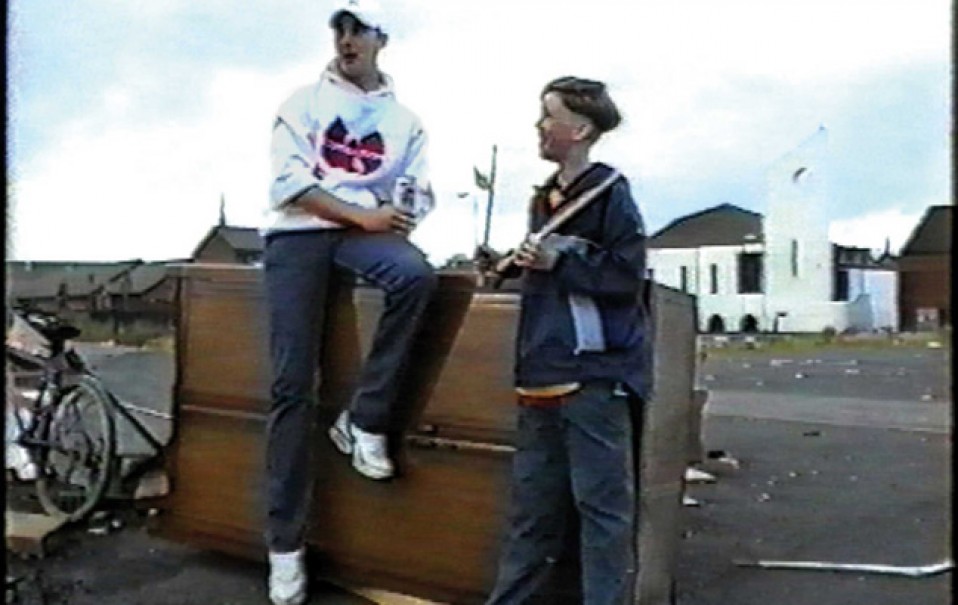
Mid-project opening
Thursday, 30 May. 6-8pm
Opening hours
Tues- Fri 1-5pm, Sat 11am-3pm
Token
Digital Arts Studios @ PS2
Sinéad Breathnach-Cashell, Jiann Hughes, Sam Ruscicia
Ends 01 June 2013
The Digital Arts Studios, this workspace, training centre, hiring agency and host of residencies for digital art in the Cathedral Quarter, is now in its tenth year. Firmly established as a kind of one-stop shop for video artists, its function lies between technical support; facilitator of new productions; and instigator of discussions and exchange. Through its residency programme, with three international residencies and 12 for UK & Ireland based artists each year, it provides a much needed platform for national/ trans-national dialogue, exposure and contacts.
In this short project, three artists show new work produced at Digital Arts Studios- DAS - during their residency.
Sinéad Bhreathnach-Cashell
The video works in this exhibition are based on the documentation made during the residency of Catalyst Campsite. It was an interactive installation with a series of live events created especially for Catalyst Arts in March 2013. These works feature performances by Uke Belfast, Karaoke Night by Ms Claire Biddles and the FAB 3rd Sandcastle Building Competition. In addition to documentation by the artist, it also includes footage shot by Rónán Breathnach-Cashell, Ray Cashell, Catherine Devlin and Emmanuelle Nègre.
The Digital Arts Studios residency was funded by the ACNI Artist Career Enhancement Scheme.
For more information about the artist see
Jiann Hughes
B-B got your beat reveals the magic of a world where our vital signs can be secretly measured. The work explores how the phenomena of publicly exposing internal bodily processes affects the subject, their heart and their social interactions. It plays on our techno-paranoia, revealing how pervasive surveillance and our growing compulsion for sousveillance may play out in the not so distant future.
This bio-sensing video work uses MATLAB software, which relies on facial recognition to measure heart beats, and Max software, to translate changes in the rhythm of the heart into sound and video. The transparency of the equipment in this work, the clinical nature of the housing and the disco inspired video effects, all hint at the innocuous applications that bore this technology.
This non-contact, bio-sensing addition to existing techniques of surveillance expands the scope of observation by allowing the condition of the human body to be interrogated, as a potential contagion or criminal.
B-B got your beat reminds us that the citizen body may now be surveilled on the inside. It is a token of foreboding.
Sam Ruscica
Two Worlds, One Wardrobe
‘Fit for the bonfire, a Twelfth of July bonfire. This was the fate of a wardrobe lying on wasteland in the Shankill until it found a new home and, in the process, told a tale of contrasting worlds. In Narnia we find a similar tale told through a wardrobe. But where Narnia was allegorical, Sam’s tale is provocatively real. These worlds are not orange and green. Against tired old themes we find the portrayal of a creative and destructive world told through the journey of the wardrobe. Youths are shown sitting on the wardrobe explaining what the Twelfth is about, telling us who William of Orange is and how they get drunk. There is little sense of hope in the barren grey landscape. The wardrobe is a piece of wood among others, awaiting its incineration on a night of enflamed exhilaration. But a new start is just around the corner when a van arrives and takes the furniture to a house for restoration. The wardrobe finds sanctuary and is transformed through the warmth of a new family. It is painted, wholesome food sits on its shelves and a future is born. Seven years on we cut to a young child telling us the story of where it came from and how it was saved. The original destiny of the bonfire is rerouted through creativity, sustenance and nurturing. There is an exploration of the social life of a ‘thing’. The inanimate object plays an active social role where it is not only acted upon by people, but assumes the role of an actor itself. In its new home the wardrobe emits radiance and a vision. It has a role in history, is recorded, thought and talked about, and remembered by a child. Its once threatened existence is to span across generations and it evolves. The genius of the short film is its longitudinal depth. We experience two divergent worlds which nevertheless meet through a wardrobe, near destruction and creation, stasis and hopeful transformation.’
Text by Patrick Leonard
Digital Arts Studio- DAS
The residency programme encourages and supports artists in the creation of innovative, challenging and experimental work by providing a creative hub with access to a range of facilities and resources. There are three international residencies and 12 UK & Ireland residencies each year. DAS provides three of the UK & Ireland residencies as awards each year.

